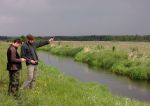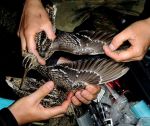The great snipe season in the Upper Narew River Valley still continues
14 czerwiec 2016
 The great snipe season in the Upper Narew River Valley still continues, albeit slowly approaching theend. In a few days we will be giving a summary of the number of lekking sites and males present in the Valley in 2016. Even now I can, however, gladly announce that despite the extreme drought in the previous year (not favourable for the survival of juveniles and adults) we observed an increase in the number of individuals of this rare species. Perhaps this is due to locally favourable hydrological conditions and the increased area of potential habitats for great snipes, created thanks tohabitat restoration efforts forming part of our Project.
The great snipe season in the Upper Narew River Valley still continues, albeit slowly approaching theend. In a few days we will be giving a summary of the number of lekking sites and males present in the Valley in 2016. Even now I can, however, gladly announce that despite the extreme drought in the previous year (not favourable for the survival of juveniles and adults) we observed an increase in the number of individuals of this rare species. Perhaps this is due to locally favourable hydrological conditions and the increased area of potential habitats for great snipes, created thanks tohabitat restoration efforts forming part of our Project.
This year we have notinstalled any telemetry devices on males, but on May 9 three female individuals were equipped with miniature (weighing only 1.5 grams) VHF radio transmitters. With these devices, using directional antennas we could find birds in the area at a distance of up to 2 km, hoping to find nests in this way. Unfortunately, a few days after the installation of transmitters the females completely "disappeared" from the range covered by our investigation. After a week, one of them was found on another lekking site, 5 km away from the one where she was captured, but yesterday was not found again. Another female suddenly reappeared ca. 2 weeks after the capture in the breeding environmentapproximately 4 km from the lekking site. After a few days of her staywe decided to startle her, hoping to find the nest. Unfortunately, the transmitter, gently glued to feathers on the bird's back, fell off prematurely on the feeding ground.
Why did the females leave the lekking ground and what is the chance to find them back?
According to the literature, females stay and nest in the direct neighbourhood of the lekking site. Results of telemetric studies conducted as part of our Project indicate, however, that this applies only to a part of birds in the population. Some females are able to move over considerable distances during the breeding season. This time we were unlucky because, as it seems, our transmitters were mounted on females from the latter group. We speculate thatwithin-seasondispersion of great snipe females may take place at a scale even larger than it is in the case of males. Let us recall that last year we found displacements of male individuals between lekking sitesreaching up to 160 km!
But let us not lose hope, and the search for females is still in progress! To illustrate the odds of finding themthe displacements which females of the great snipe can achieve during the breeding season, I will quote the example of one of them, equipped with a GPS transmitter in 2014.
This individual has covered the distance of at least 475 kmfrom May 15 (most likely after the loss of her brood), visiting Belarus and Lithuania, and on the way back stopping by at a lekking site (!) In the central basin of the Biebrza River.To what purpose did she visit the lekking site at the Biebrza River we can still guess, but how has the bird learned about its location remains a mystery. After her return (May 26) to the Upper Narew River Valles the nest has been found, only 100 meters from the lekking site. Unfortunately it was destroyed, most likely by a fox, just a week before hatching. This example demonstrates how little we know about the breeding biology of this species, the knowledge of which is the key to planning an effective protection of the great snipe.
The chances that the missing females will reappear in the range of our antennas are therefore very slim; it can be confidently compared to the search for a needle in a haystack. However, until they are there,no fieldwork will take place without the soft humming coming from the VHF receiver.
Michał Korniluk
PS. Searching for the lekking ground based on the attached map will be pointless, its location has been on purpose moved by many kilometers;) I apologize for this harmless forgery, this was done in order to assure the protection and safety of great snipes.










